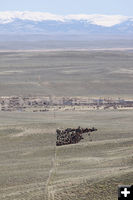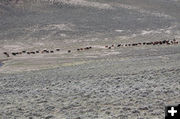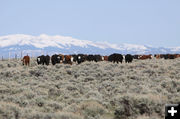

Turning Out
Turning yearlings out on the Mesa in 2009. Photo by Jonita Sommers.
|


To Soaphole Draw
Taking yearlings out to spring allotment on spring allotment in Soaphole Draw in 2009. Photo by Jonita Sommers.
|
|
Spring Pasture
by Jonita Sommers
May 17, 2010
The grass is green. The birds are back in the Green River Valley. The antelope have moved north. The cows are calving or have calved. The air is warmer and May flowers are blooming. All of these events are signs of spring and the time when cattle are turned out on the open range. May first to June first is when ranchers put their cattle from the hay meadows to the BLM sagebrush lands for spring pasture. For days, the old cow has been watching to see if the gate to the spring range is open. As the old cow sees the open gate to the sagebrush range, she charges through the gate heading for her favorite spot in the allotment. The calves have to hustle to stay with their mothers. Spring has officially started.
When the Green River Valley was settled in the 1800s and early 1900s, an individual would file on land through a homestead entry of 160 acres or a desert land entry of 320 acres. This was not enough land to run a herd of cattle large enough to make a living. It takes 3-33 acres per animal unit per month (AUM) to take care of one cow in the basin and foothills depending on the amount of moisture. In the foothills and mountains, it takes 1-6 acres per (AUM) to take care of one cow. Before the Equalizer Winter of 1889-90, the ranchers ran their cattle on federal land year round without feeding hay. After this winter killed nearly 90% of the cattle, the ranchers started growing hay crops during the summer to feed in the winter. The cattle were still run on federal land from spring through fall. At this time, the federal government did not control or monitor the cattle grazing on federal land. In 1906, the Forest Service issued the first grazing permits on federal land. The land that would be under the Bureau of Land Management (BLM) would not see any control over the use of cattle until 1937 when the Taylor Grazing Act of 1934 brought about grazing permits being issued on the rest of the federal land.
The Grazing Service, and later the BLM starting in 1946, brought about management plans, water development and grazing allotments as the years progressed.
Reservoirs were built and wells were drilled for windmills and later propane engines to pump water. The water development not only benefited the cattle so they could graze land that was not accessible because of lack of water, it also helped the wildlife immensely by giving animals such as antelope and sage grouse watering holes. The grazing allotments made it possible for cattle to be managed in a manner that would not hurt the vegetation. Since the 1990s, ranchers have done range monitoring along with the BLM range con, who had been doing range monitoring for years.
Some ranchers have private allotments in the foothills and haul or drive their cattle to and from the private pasture. This is for another story.
|



